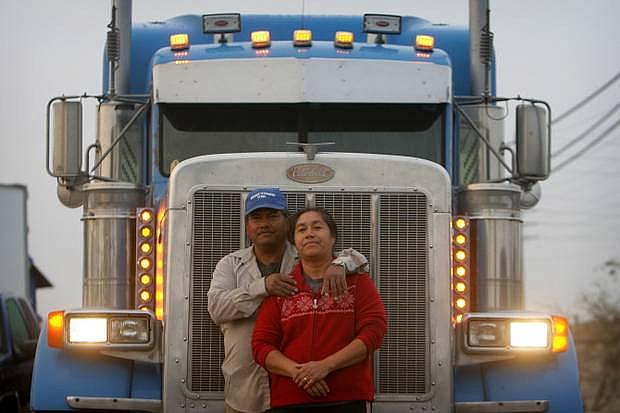TRUCKING: A job opportunity for former dairyman
Truck driver Jose Rodriguez can attest that the flow of goods through the Inland Empire region provides job opportunities. He also knows that cutting air pollution from trucks is a priority — and, in some cases, a hardship.
This report was produced in part with a grant from the Lucile Packard Foundation for Children's Health Journalism Fund, awarded by The California Endowment Health Journalism Fellowships at the USC Annenberg School of Journalism.
Other portions of this story:
AIR POLLUTION: Battle still on for clean air
POLLUTION: Microscopic particles can cause internal havoc
CLEAN AIR: Reducing air pollution extends lives
CLEAN AIR: A promise still elusive for Inland region
HEALTH: Children are more vulnerable to air pollution effects

Jose Rodriguez and his wife, Maria, with their truck near their home in Jurupa Valley. The family makes a living moving goods around the nation. Photo Credit: STAN LIM/STAFF PHOTOGRAPHER
Jose Rodriguez cared for calves at Inland dairies for about 20 years, until an exodus of the farms from Chino, Ontario and Jurupa Valley left him looking for work.
After some construction jobs, he saw a chance for a new career. In 2001, he spent about $2,000 for training to become commercial driver and soon was hired by a trucking company.
He saved his money and, in 2004, bought a truck — a 2000 model Peterbilt tractor with a flatbed trailer — and went into business for himself. He has since added a second truck, providing work for a cousin and his son, Roberto, who is a student at Cal State San Bernardino.
“This is better,” Rodriguez, 53, said of his trucking business. On this day, he was headed east from Los Angeles on Highway 60, on his way to Phoenix with a load of heavy machinery strapped to his flatbed.
“I make more money, and I can sometimes take two or three days off,” he said.
Rodriguez can attest that the flow of goods through the Inland region provides job opportunities. He also knows that cutting air pollution from trucks is a priority — and, in some cases, a hardship.
He has until Jan. 1 to retrofit his Peterbilt with a state-approved particle trap that will greatly cut the truck’s soot emissions.
As he navigated late-afternoon traffic in the San Gabriel Valley, he said he didn’t know whether it be would better for him to invest in a new truck or buy the particle trap.
He eventually opted for the filter, which will cost him about $15,000, said his son, Roberto. “We are going to have to finance it. We have to have working capital.”
The particle traps are required under California AirResource Board rules approved in 2008. They call for a phase-in of truck and bus particle traps or replacement of older vehicles; the goal is a 90 percent reduction in toxic diesel soot emissions by 2023.
State officials estimated the new rules would cost the California trucking industry $5.5 billion by 2023, but the California Trucking Association said the cost would be much higher, as much as $1 billion a year.
The resulting pollution cuts are expected to save about 9,400 lives in California between 2010 and 2025 and at least $48 billion in illness-related costs, according to air board estimates.
Jose Rodriguez has little trouble staying busy, a testament to the tremendous volume of goods that need to be moved through Southern California every day.
During one week earlier this year, he picked up a load of pipe in Rialto and hauled it to Idaho. After making the delivery, he took on a shipment of composite decking material in Meridian, Idaho, and by Thursday, he had delivered it to a Home Depot warehouse in La Mirada.
Then it was off to Long Beach to load up and secure several tarp-shrouded heavy machines from China. Getting the machines on board and tied down took about three hours.
With extra room left on flatbed, he headed to Fullerton, intending to retrieve additional cargo.
He changed direction, however, when Roberto, his son, advised him by cell phone of a better opportunity. By checking Internet listings of loads available for independents, Roberto Rodriguez found a better-paying load in Los Angeles, where plastic containers of boiler cleaning fluids were destined for Phoenix.
Roberto Rodriguez said he finds loads for others truckers, too, allowing him to earn brokerage fees.
His father had been gone about 12 hours by the time he returned to a truck yard in Jurupa Valley to drop off his rig. After a dinner break, he would head east to Phoenix after dark to make his deliveries. And his son was on a hunt for a load to take back California the next day.
“Economically, we live better because he works as a truck driver,” his wife, Maria, said in Spanish through an interpreter. “But it is hard because … he works longer is gone more.”

